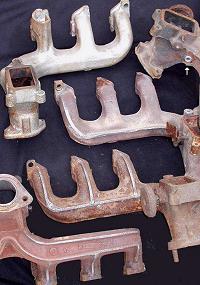
By Dan Stern, photos & layout by D. Dutra
Slant Six Exhaust Manifold Installation
By Dan Stern,
photos & layout by D. Dutra
We will review the different exhaust manifolds available for the SL6 and
discuss manifold preparation / installation
All SL6 exhaust manifolds are
basically the same and will interchange with all SL6 engines 1960-86. There were
some minor changes made to the exhaust manifolds over the years which added more
reinforcement ribs and changed the choke stove pocket design. The first SL6
exhaust manifolds had no external ribbing and as a result, these crack and break
easily. From these first manifold castings, this long cast iron exhaust manifold
would prove to be a challenge to keep in one piece, as a result, the engineers
added reinforcement ribs in an attempt to prevent cracking. Two external ribs
were added in 63 to stiffen the body of the manifold. 1970 saw another bottom
rib and ribs running up each runner "leg" added, along with a revised (round)
heat riser valve counterweight. By 1980 a thick section was added to the heat
riser area's rear wall and this "boss" was drilled and tapped for an O2
sensor.
 The
important thing to remember is that this big-long exhaust manifold is designed
to "slide" across the gasket surface and move around as it heats & cools. A
stamped steel gasket is the best for allowing movement but is also the hardest
to seal. The thick material gaskets are the opposite, easier to seal but they
don't allow much manifold movement, which can lead to a cracked manifold. The
manifold hardware is an important part of the installation. The special
washers allow the manifold some movement while holding it down for sealing. The
correct hardware must be used in the proper locations. The two acorn nuts go on
the two top, outer end studs, with the coned shaped part of the nut fitting into
the
The
important thing to remember is that this big-long exhaust manifold is designed
to "slide" across the gasket surface and move around as it heats & cools. A
stamped steel gasket is the best for allowing movement but is also the hardest
to seal. The thick material gaskets are the opposite, easier to seal but they
don't allow much manifold movement, which can lead to a cracked manifold. The
manifold hardware is an important part of the installation. The special
washers allow the manifold some movement while holding it down for sealing. The
correct hardware must be used in the proper locations. The two acorn nuts go on
the two top, outer end studs, with the coned shaped part of the nut fitting into
the 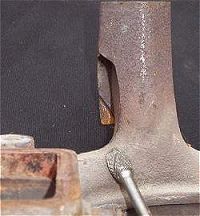 dished/conical part of the round brass washers. The
center three studs get cup-shaped round cast iron washers, cupped faces towards
the head. Everything else gets triangular butterfly washers. (Link
to more manifold installation instructions) Note
dished/conical part of the round brass washers. The
center three studs get cup-shaped round cast iron washers, cupped faces towards
the head. Everything else gets triangular butterfly washers. (Link
to more manifold installation instructions) Note 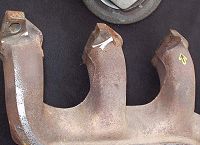 that
"later" SL6 engines came with only one round conical washer in the top center
position, all the other were triangular type. This combination is also
acceptable but installation of the lower, inner triangle washers can be a
challenge, especially the one under the choke stove mounting pocket. A little
grinding of the parting line in this location really helps to get socket access
to that nut. All the tab surfaces where the washers contact the manifold must be
smooth and allow clearance on all sides. You may have to grind the sharp corners
off the edges of the tab cutouts to ensure this. I use some anti-seize compound
on the resurfaced flats to help the manifold "float" under the washers.
that
"later" SL6 engines came with only one round conical washer in the top center
position, all the other were triangular type. This combination is also
acceptable but installation of the lower, inner triangle washers can be a
challenge, especially the one under the choke stove mounting pocket. A little
grinding of the parting line in this location really helps to get socket access
to that nut. All the tab surfaces where the washers contact the manifold must be
smooth and allow clearance on all sides. You may have to grind the sharp corners
off the edges of the tab cutouts to ensure this. I use some anti-seize compound
on the resurfaced flats to help the manifold "float" under the washers.
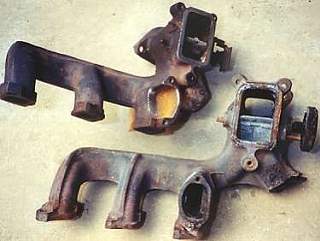 Choke Spring
(stove) Mounting:
Choke Spring
(stove) Mounting:
The choke stove mounting pocket came in three permutations:
-
A cast-in pocket with a small section of the rear casting wall
missing.
- A pocket area open to the exhaust port and the use of a stamped
steel "cup and gasket" to seal the hole.
-
A cast-in pocket with the entire rear wall removed, this allows room for the
Super Six 2 bbl chock stove.
There are different choke stoves for these different pockets so be sure to use the correct unit. The spring tension can be adjusted on many of these by using a 3/8 wrench on the spring retaining nut and rotating the spring's anchor point.
Gaskets:
The factory used a stamped steel gasket between the manifold set and head,
this worked well on the freshly machined surfaces of new engines. For used /
worn surfaces, use a composition gasket--I like NAPA's #MS-16030 better than
Fel-Pro's gasket for this 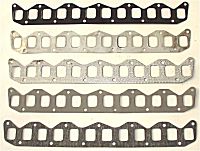 application. There is also the very thick Mr. Gasket
#320 as well as special "engineered
application. There is also the very thick Mr. Gasket
#320 as well as special "engineered material" gaskets from Cox Performance and Clifford. These can be useful if you
suspect leakage from from headers because of flange warping. The
original type embossed metal shim (thin) gaskets don't seal well on used
surfaces that are pitted or not completely flat. Forget about the "Fig Newton"
gasket, (paper on the intake ports, metal on the exhaust) because these take
extra intake / exhaust manifold realignment work to get sealed. This
"two-in-one" gasket was sold by McCord and (sometimes) Chrysler's aftermarket
parts department. There are a number of different
gasket types used for the inter-manifold and header pipe flange connection
so look at different manufacture's sets if you have a need for a special
type.
material" gaskets from Cox Performance and Clifford. These can be useful if you
suspect leakage from from headers because of flange warping. The
original type embossed metal shim (thin) gaskets don't seal well on used
surfaces that are pitted or not completely flat. Forget about the "Fig Newton"
gasket, (paper on the intake ports, metal on the exhaust) because these take
extra intake / exhaust manifold realignment work to get sealed. This
"two-in-one" gasket was sold by McCord and (sometimes) Chrysler's aftermarket
parts department. There are a number of different
gasket types used for the inter-manifold and header pipe flange connection
so look at different manufacture's sets if you have a need for a special
type.
Gasket Goop:
Sometimes sealer is helpful, other times it is not. If your manifolds and/or
the head surface is warped, it can
mean the difference between a successful seal or the "rework" of a
time-consuming task. The cardinal rule of gasket sealer is best remembered by
thinking back to the cardinal rule of grammar-school arts and crafts: "DON'T BE
A PASTE WASTER!" In other words, use any sealer sparingly, you do not need a lot
to do the job. There is an open debate on where to use what type of sealer. In
general, most agree that you can use a good high temp. sealer on the gasket face
contacting the head, as well as sealer on both sides of the "heat box"
inter-manifold gasket used between the intake and exhaust manifolds. As for
using sealer on the gasket surface contacting the manifold ports, I coat that
side, Dutra puts a little around the intake ports only and other use no sealer
on that side, many racers use no sealer at all. Do what works best for your
manifold set-up.
it can
mean the difference between a successful seal or the "rework" of a
time-consuming task. The cardinal rule of gasket sealer is best remembered by
thinking back to the cardinal rule of grammar-school arts and crafts: "DON'T BE
A PASTE WASTER!" In other words, use any sealer sparingly, you do not need a lot
to do the job. There is an open debate on where to use what type of sealer. In
general, most agree that you can use a good high temp. sealer on the gasket face
contacting the head, as well as sealer on both sides of the "heat box"
inter-manifold gasket used between the intake and exhaust manifolds. As for
using sealer on the gasket surface contacting the manifold ports, I coat that
side, Dutra puts a little around the intake ports only and other use no sealer
on that side, many racers use no sealer at all. Do what works best for your
manifold set-up.
For a long time, high temp. RTV Silicone was the only option for exhaust manifolds. Now, there is something better for this application. It is a blue polymeric gel called "Hylomar". It is much, much easier to work with, more flexible, more removable, and generally much better suited to this application. I have had excellent success with the variety in the squeeze tube labeled "Hylomar HPF/High Performance Formula". Make a thin ring, (you don't need much) around each port on one side of the gasket. It doesn't need to be used so thickly that it gooshes out all over the place but be sure there is an unbroken ring around each port opening. Put the coated gasket on the clean cylinder head surface and press it into place with your fingertips. Now, it's easier to put beads of Hylomar on the manifold side, instead of trying to figure out a way to spread Hylomar on both sides of the gasket before installing it.
Manifold Preparation:
The first step before you disassemble the manifold set is to check the intake
to exhaust
manifold port alignment. Run a straight edge along the bottom of the port
openings or use a new gasket to see if the exhaust manifold is warped. Pay close
attention to the end exhaust manifold ports, it is common to see these ports
slightly higher then the others in the row. If the end ports are higher by more
then .100 it will be difficult to get the end ports to seal. (Very little gasket
contact area remains) It is possible to do some minor location adjusting by
"offset" grinding / filing on the heat box contact surfaces, between the two
manifolds.
After you've disassembled the intake from the exhaust, inspect for
cracks and deburr the manifolds. The port openings are the obvious places to
grind but also do some work around the cutouts where the triangular spanner
washers seat. Another
good place to grind is under the choke stove pocket so you have a little
more room to fit-in your socket for easy assembly. I also smooth-out any ragged
casting parting lines or sharp edges just so I don't nick myself on these while
doing the assembly work. 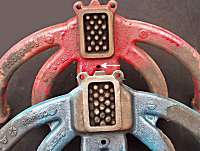 Next,
clean the heat pocket area of the intake. This is the area on the underside of
the intake manifold where it connects to the exhaust manifold. Use a screwdriver
to scrape-away all the carbon buildup in the manifold's heat pocket "hot spot"
area. Really scrape hard in all directions to chip away as much of the stuff as
possible. A spray can of Berryman B12 ChemTool carburetor cleaner helps here. If
you wish to be fastidious, have the manifold media blasted. (bead, sand, brake
lathe shavings, whatever your local blaster uses) Removing all the carbon from
this heat transfer area helps heat transfer to the intake. Note that later
intake manifolds have a larger carb. heat pocket and have a larger hole to
accept a 3/8 - 16 unc stud in the inner position. earlier intake manifolds will
need to have this hole drilled-out if they are to be used with later exhaust
manifolds using the larger stud. Washout the reworked manifolds completely after
your are done and repaint . This is especially important with intake manifolds
that have been media blasted.
Next,
clean the heat pocket area of the intake. This is the area on the underside of
the intake manifold where it connects to the exhaust manifold. Use a screwdriver
to scrape-away all the carbon buildup in the manifold's heat pocket "hot spot"
area. Really scrape hard in all directions to chip away as much of the stuff as
possible. A spray can of Berryman B12 ChemTool carburetor cleaner helps here. If
you wish to be fastidious, have the manifold media blasted. (bead, sand, brake
lathe shavings, whatever your local blaster uses) Removing all the carbon from
this heat transfer area helps heat transfer to the intake. Note that later
intake manifolds have a larger carb. heat pocket and have a larger hole to
accept a 3/8 - 16 unc stud in the inner position. earlier intake manifolds will
need to have this hole drilled-out if they are to be used with later exhaust
manifolds using the larger stud. Washout the reworked manifolds completely after
your are done and repaint . This is especially important with intake manifolds
that have been media blasted.
Get a can of genuine Chrysler MoPar Manifold Heat Control Valve solvent, available at any Chrysler Corp. dealer, to lube the heat riser valve bushing, this is a must, nothing else works as well. Spray this stuff liberally on inner and outer ends of both heat control valve bushings and work the valve back and forth, flushing / lubing with the heat control valve spray. Do this until the flap operates smoothly and freely. If it is stuck fast, remove the counterweight, (The early flat type counterweight comes off fast) flood the bushings with the solvent spray and whack the ENDS of the shaft with a good hammer. Keep spraying and whacking the shaft back and fourth until it frees-up. A little heat can help free-up a really stuck one.
Next, you'll want to carefully prepare the surfaces for the new metal inter-manifold gasket. The current stamped steel replacement gaskets are poorly designed and tough to persuade to make a good seal so clean and file flat the contact areas. The old, long-obsolete "problem solver" gasket (a thicker metal-asbestos-metal sandwich material gasket) was much better at sealing a worn and pitted surface. My experience has taught me that unless you have reground these surfaces or have a brand new intake and a brand new exhaust manifold, this all-metal gasket simply will not seal on a worn surface. This is the place to use High Temp. RTV Silicone. I use copper high-heat RTV from the parts store or Chrysler Mopar High-Temp RTV to help ensure a seal.
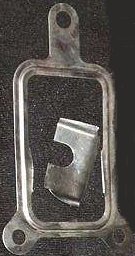 Before we
get to the actual application of goop to this gasket, you will need to modify
the stamped steel gasket slightly, if you plan to use it with a '70 or older
exhaust manifold. Most of these gaskets have a "bridge" part that runs across
the center opening, from side to side. This was intended to help direct the flow
of exhaust through the hot spot pockets in later manifolds, but this section of
the gasket interferes with the top of the '70 and earlier manifold heat control
valve "flapper", which sits higher in the exhaust manifold. The later valves are
mounted lower in the manifold and don't hit the gasket. To make the
modification, use a cutoff wheel in a Dremel tool or sharp shears (fast) or a
file or saw (slow) to cutback the straight (non-curved) end of the bridge.
Backcutting this bridge by about 1/8" will solve the interference problem, or if
you're running a '72 or earlier intake, you can remove the bridge entirely. The
valve catches on the corners of the bridge where it meets the side rails of the
gasket. All of this will make sense once you see it, but note that the
interference won't happen until everything is assembled and torqued, so if you
have the early style heat control valve, DO THE MODIFICATION, otherwise your
heat control valve may not work right or will get jammed in the closed position
on the early style manifolds.
Before we
get to the actual application of goop to this gasket, you will need to modify
the stamped steel gasket slightly, if you plan to use it with a '70 or older
exhaust manifold. Most of these gaskets have a "bridge" part that runs across
the center opening, from side to side. This was intended to help direct the flow
of exhaust through the hot spot pockets in later manifolds, but this section of
the gasket interferes with the top of the '70 and earlier manifold heat control
valve "flapper", which sits higher in the exhaust manifold. The later valves are
mounted lower in the manifold and don't hit the gasket. To make the
modification, use a cutoff wheel in a Dremel tool or sharp shears (fast) or a
file or saw (slow) to cutback the straight (non-curved) end of the bridge.
Backcutting this bridge by about 1/8" will solve the interference problem, or if
you're running a '72 or earlier intake, you can remove the bridge entirely. The
valve catches on the corners of the bridge where it meets the side rails of the
gasket. All of this will make sense once you see it, but note that the
interference won't happen until everything is assembled and torqued, so if you
have the early style heat control valve, DO THE MODIFICATION, otherwise your
heat control valve may not work right or will get jammed in the closed position
on the early style manifolds.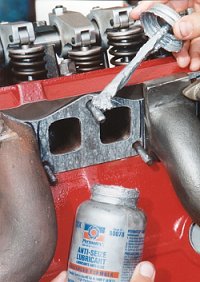
To prep the inter-manifold gasket, brush/blow off all the chips from the
bridge modification and then goop a medium-heavy layer of high heat RTV silicone
gasket material on both sides of the gasket, all the way around its rectangular
perimeter, let the RTV "skin-over" for half an hour or so. To install the
manifold set, carefully place the "gooped-and-skinned" inter-manifold gasket
right-way-up between the two manifolds, then just snug the three
intake-to-exhaust bolts with your fingers, (new, grade 8 bolts, coated with
anti-seize, if you ever want to take them out again without breaking them.) then
install the pair of manifolds onto the cylinder head, on which you've placed the
prepared 12-port gasket.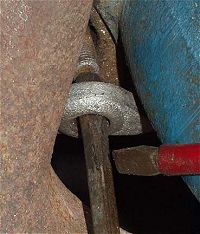
Install all the washers and nuts. I like to use Dorman's brass nuts on the studs, because they don't seize and they look nice. A brush coat of 'Led Plate' (Briggs and Stratton 93963) or another good metallic anti-seize compound on the stud threads and on the three bolts is a wise move.
As for putting the bottom triangular washers onto the studs, it's easier if
you put one washer on the shaft of a phillips head screwdriver or rod, then
touch the screwdriver to the stud, then use another driver to slide the washer
onto the stud. Another technique is to loop a piece of sewing thread or fishing
line through the washer eye, then lower the washer down between manifold
runners, guiding the washer onto the stud with a long screwdriver or
probe.
Tighten the manifold-to-head nuts; start at the center and work
outward to snug, then go back and torque the three intake-to-exhaust bolts to 22
foot pounds. now go back and torque the head fasteners to 10-12 pound-feet of
torque, again from the center outward.
--------------------------
A couple of additional comments on getting the factory intake & exhaust manifolds assembled and sealed-up properly:
Check any used manifold for warpage, use the gasket as your "inspection
tool". If the end exhaust ports are more then 1/8" higher then the intake port
next to it, best find another manifold.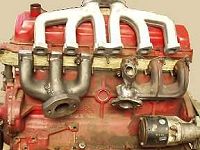
Always do a "dry run" fit check, assemble the intake manifold to exhaust manifold, with no gasket and the center 3 heat riser bolts "making light contact" but not torqued. Place the assembly directly on the head surface, no gasket and install the fasteners. Look for warpage by using a .010 feeler gauge along the gasket surfaces and mark any places where the gauge slips in. Check the exhaust pipe connection point to be sure the pipe flange meets the manifold surface square and flat, this will give even "crush" on the gasket for a trouble free seal. Inspect around each washer and stud, do some grinding to remove casting flash or make additional clearance if you see any contact.
Remember, this big-long exhaust manifold is designed to "slide" across the gasket and move around as it heats & cools. If you pin it down by over-tightening or because it butts-up on something, the manifold will flex, warp, crack, etc. Be sure the exhaust manifold does not contact a stud or that the washers do not rotate and jam-up in the machined tab notch(s) as you tighten them. Use the correct brass washers on the top/end studs. The only thing that should contact the exhaust manifold are the faces of the washers, not their sides, not the studs, not the intake.(except at the center heat riser pad) Grind away any interference. Do not "force-on" the assembly or it will eventually crack the exhaust manifold, a stud or both.
To align the two manifolds, assemble the manifolds with the 3 heat riser bolts making light contact. (it is a good idea to use "anti-sieze" on all bolts & washer faces) Now install the assy. and all the washers / nuts so they make light contact. Go back and tighten the 3 heat riser area bolts. Check for gaps and resurface or realign parts as needed to remove gaps.
I have a bunch of "special tools" to help with the washer / nut install, the best tool I have is a 1/2" socket with a magnet "insert" that holds the nut right at the the tip of the socket. This keeps the nut from falling out or getting pushed-up into the socket as you try to get it started onto the stud. always tighten the head stud washer nuts from the *center* and work outwards in order to prevent any wrinkles in the gasket. (just like a head gasket, squeeze it out towards the ends)
-------------------------------------------------------------------
"Dutra Duals", Cast Iron Dual Exhaust Set - Installation Instructions
To install the Dutra Cast Iron Dual Exhaust Set is about the same as the
replacement of a factory exhaust manifold. It is always 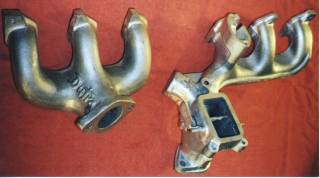 a good
idea to align the altered rear manifold section with the intake manifold and
then have the assembled pair surfaced
ground flat, this insures a clean and perfectly matched gasket surface. You
can align the pair by first assembling the two manifolds, along with the
stainless steel heat riser gasket and the 3 attaching bolts. (It best to use new
bolts at this location, the old ones get pretty crystallized and brittle)
Tighten these bolts until they make contact but do NOT "crush" the gasket at
this point. Install the assembly on to the cylinder head studs (without the
intake / exhaust gasket) and assemble all the spanner washers and nuts. Draw
these down until they make contact but do NOT torque. Now go back to the 3
through bolts assembling the intake to the rear exhaust manifold section and
tighten these bolts to 15 foot-pounds. Use this opportunity to check
a good
idea to align the altered rear manifold section with the intake manifold and
then have the assembled pair surfaced
ground flat, this insures a clean and perfectly matched gasket surface. You
can align the pair by first assembling the two manifolds, along with the
stainless steel heat riser gasket and the 3 attaching bolts. (It best to use new
bolts at this location, the old ones get pretty crystallized and brittle)
Tighten these bolts until they make contact but do NOT "crush" the gasket at
this point. Install the assembly on to the cylinder head studs (without the
intake / exhaust gasket) and assemble all the spanner washers and nuts. Draw
these down until they make contact but do NOT torque. Now go back to the 3
through bolts assembling the intake to the rear exhaust manifold section and
tighten these bolts to 15 foot-pounds. Use this opportunity to check 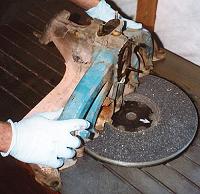 clearance around all the hardware and the general fit
and finish of the assembly. Now the assembly is aligned and you can remove it
for resurfacing if needed. (you can now check it with a straight edge)
clearance around all the hardware and the general fit
and finish of the assembly. Now the assembly is aligned and you can remove it
for resurfacing if needed. (you can now check it with a straight edge)
Before starting the final assembly process, it is a good idea to mark
the new intake / exhaust manifold gasket with reference marks to aid in aligning
the head ports with the manifold passages. Set the new gasket on the
manifolds and lineup the passage opening with the gasket. Once correctly
located, reach around and "trace" the manifold's edges onto the gasket with a
felt pen. You do not have to get all the way around all the ports, just do a few
places you can see while assembling the set-up. Doing this is more important for
the front Dutra 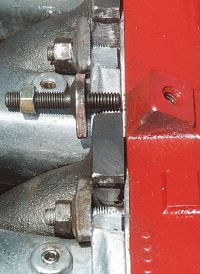 casting
because it is no longer connected to the intake and can "float" on the mounting
surface and get out of alignment with the head ports.
casting
because it is no longer connected to the intake and can "float" on the mounting
surface and get out of alignment with the head ports.
Install the new gasket and manifolds using all the factory spanner
washers (the 1970 and later "thick ones" are the best) and be sure to use the
brass washers and castle nuts on each top end-stud. Watch to make sure the
spanner washers DO NOT rotate and butt their edges against the mounting ear
cutouts on the manifold. 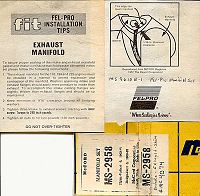 The
manifolds need to "float" on the head as they heat and cool so allow clearance
EVERYWHERE. If you "pin-down" the manifold(s) because of interference or over
tightening, they will flex, crack and break. All the nuts should be torqued to
10 - 15 foot pounds max. Once you have heated and cooled the engine, recheck the
tightness of the nuts. Now it's off to the exhaust shop to get the pipe work
done. You can run 2 - 2 inch pipes all the way back (a "balance tube" connecting
the two at mid car helps mid range power) or run 2 - 2 inch pipes till your
under the car then "Y" back into a single bigger pipe and muffler (2 1/4 or 2
1/2 inch) for the remainder of the system. The first system makes a bit more
top-end power, the second is quieter. Your choice!
The
manifolds need to "float" on the head as they heat and cool so allow clearance
EVERYWHERE. If you "pin-down" the manifold(s) because of interference or over
tightening, they will flex, crack and break. All the nuts should be torqued to
10 - 15 foot pounds max. Once you have heated and cooled the engine, recheck the
tightness of the nuts. Now it's off to the exhaust shop to get the pipe work
done. You can run 2 - 2 inch pipes all the way back (a "balance tube" connecting
the two at mid car helps mid range power) or run 2 - 2 inch pipes till your
under the car then "Y" back into a single bigger pipe and muffler (2 1/4 or 2
1/2 inch) for the remainder of the system. The first system makes a bit more
top-end power, the second is quieter. Your choice!
------------------------------------------------
Some Comments on SL6 Headers:
Sad to say that you must assume the worst when planning to install headers
onto a SL6. Many times the header flange(s) are warped right out of the box so
run a straight edge across the ports to check for flatness. Most SL6 headers are
big and will take some work to get into the engine compartment. Once you get the
header(s) "bolted-up" you may find that they bang on something or hang low to
the ground. Some headers trap the starter motor or run pipes so close to it that
they cook the starter. Power steering and manual shift clutch linkage can
present clearance problems.
For these reasons, plan lots of extra time to do
a header installation. Plan on doing at least one "trial fit" to see if and
where any clearance problems are. If you find an interference point, make a
"template" showing where the pipe needs to be moved and have a welder (exhaust
shop) relocate the tube(s).
The
thick paper or special material gaskets help get headers sealed. Note that
headers do not attach to the intake so mark
your gasket to help align the intake ports during installation. Headers do
not provide carb heat or a place to mount the choke stove. These features can be
added but it is more custom fabrication work. There are many different types of
SL6 headers out there so be sure you get the set that is designed to fit your
car. (This is hard to know when buying used headers)
Copyright 2002, no reproduction without permission - www.slantsix.org